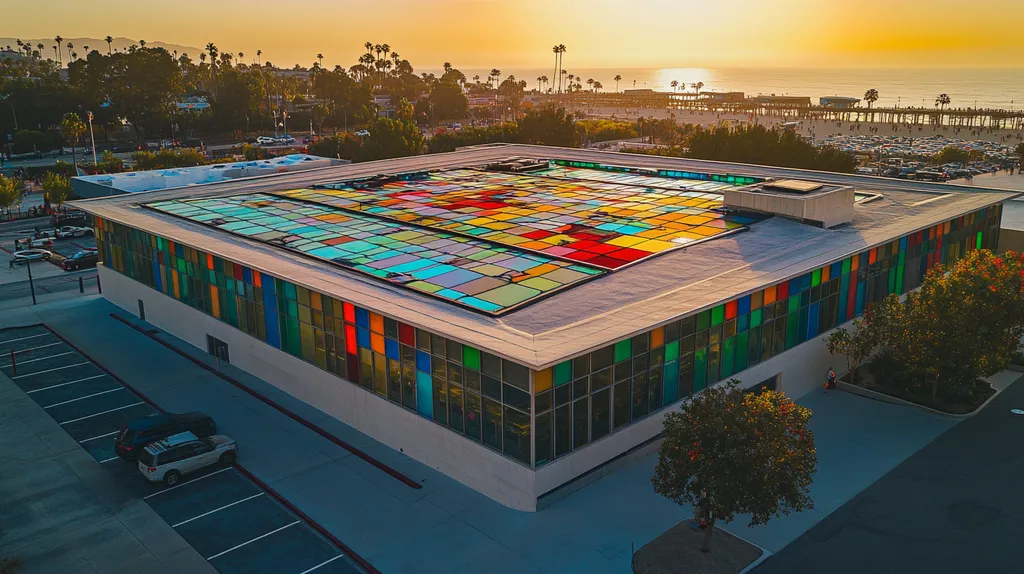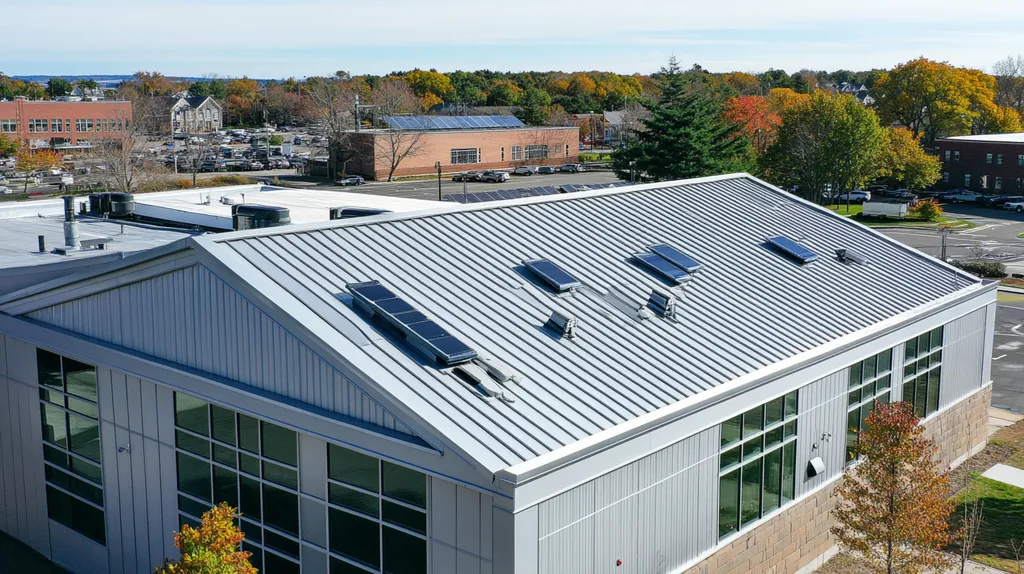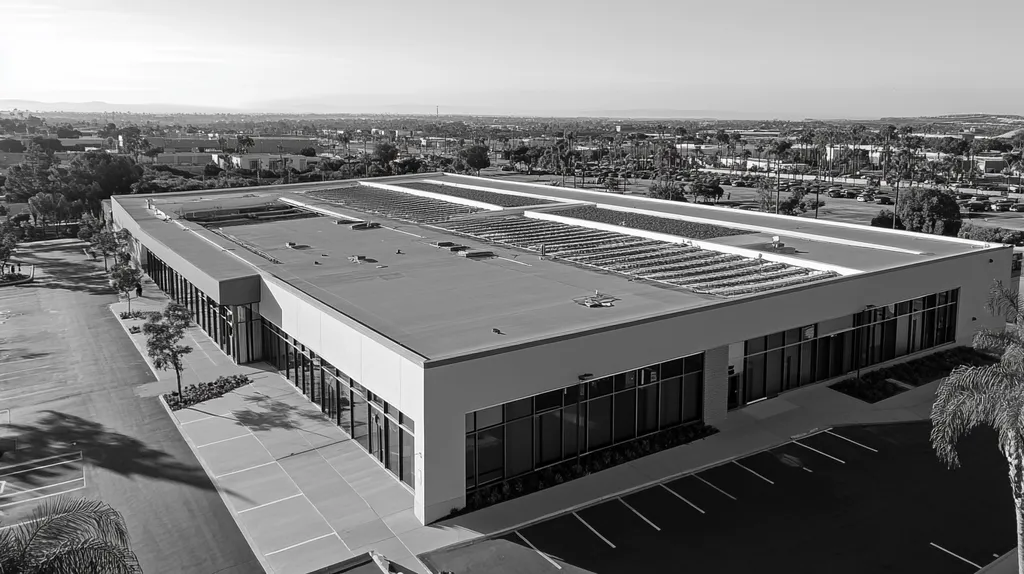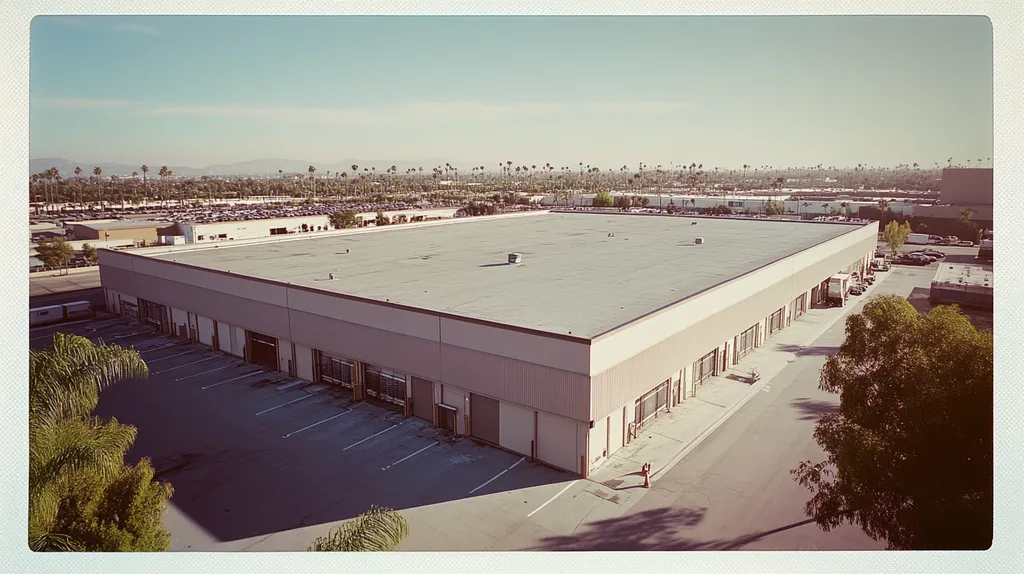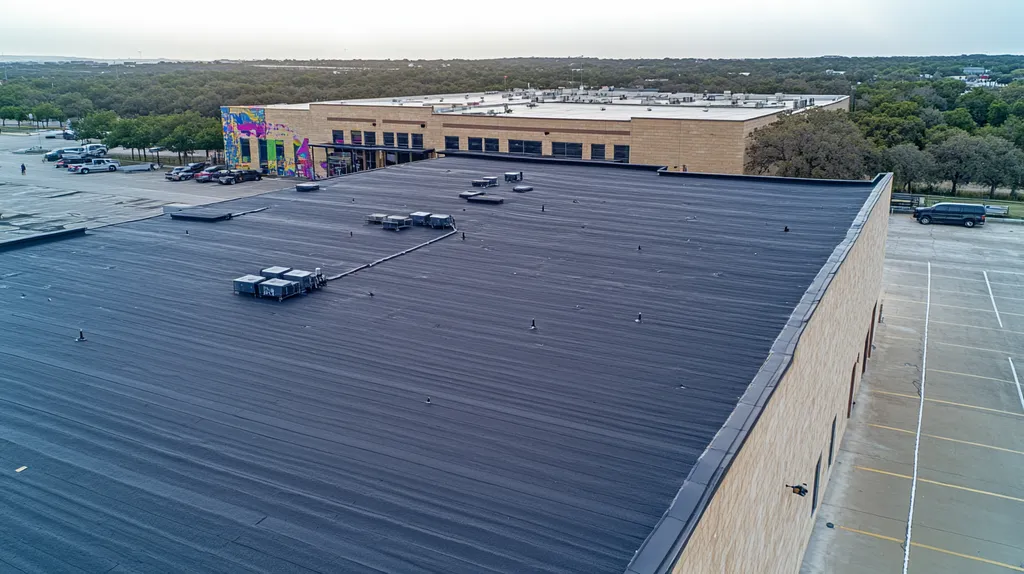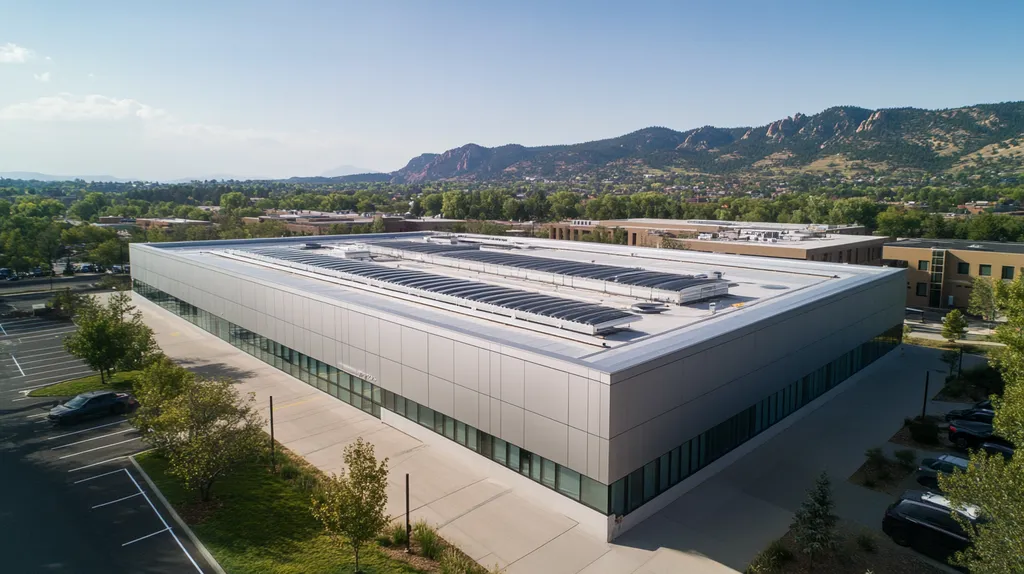As energy costs soar and environmental regulations tighten, commercial property owners face mounting pressure to adopt green roofing technologies. Buildings currently contribute 39% of carbon emissions in the United States, making sustainable roofing solutions no longer optional but essential for compliance and profitability.
From solar integration to living roof systems, green technologies offer proven solutions for reducing operational costs while meeting stringent environmental standards. Studies show that energy-efficient roofing can slash cooling expenses by up to 50% while extending roof lifespan by 200-300%.
This comprehensive guide provides facility managers with actionable steps for evaluating, implementing, and maintaining green roofing technologies across six critical areas: performance metrics, financial considerations, compliance requirements, risk management, operational procedures, and long-term planning.
SECTION 1: PERFORMANCE FACTORS
Embracing green technologies in commercial roofing is no longer a luxury; it’s a necessity. With energy expenses on the rise and stricter environmental regulations in place, property managers must prioritize roofing solutions that boost sustainability while lowering operational costs. Notably, buildings contribute approximately 39% of carbon emissions in the United States, making energy-efficient roofing crucial for compliance and long-term profitability. This section highlights essential performance factors: energy efficiency metrics, thermal insulation and heat island mitigation, and indoor air quality improvement.
Energy Efficiency Metrics
Energy efficiency metrics are essential in assessing roofing options. Understanding how much energy a roofing system can save directly influences a facility’s financial health. The Energy Star program indicates that energy-efficient roofs can cut cooling energy expenses by as much as 50%. This metric is vital not only for managing operational costs but also for enhancing overall building performance.
Looking at long-term effects, a well-insulated roof minimizes heating and cooling needs, which results in lower greenhouse gas emissions. Choosing the right roofing system impacts energy consumption and adds market appeal as a sustainable choice.
Moreover, infrared reflectance and emissivity are critical to energy efficiency. Roofing materials that effectively reflect sunlight contribute to cooler buildings and reduced energy usage. Facility managers should prioritize materials with high Solar Reflectance Index (SRI) ratings to optimize efficiency.
Key Action Items
Thermal Insulation and Heat Island Mitigation
Thermal insulation is a vital component of roofing systems, significantly impacting heat transfer management. Effective insulation keeps indoor temperatures stable, enhancing comfort while reducing energy usage. The right roofing materials can limit heat gain, which is particularly beneficial in warmer climates.
The urban heat island effect is increasingly concerning as cities become warmer than rural areas due to human activities and conventional building materials. Many commercial roofs exacerbate this issue by absorbing and retaining heat.
Green roofing solutions, such as vegetative or reflective roofs, can help counter this effect. Research shows that green roofs can lower ambient temperatures by up to 7°F, which enhances energy efficiency and fosters a healthier urban atmosphere.
Key Action Items
Indoor Air Quality Improvement
Indoor air quality (IAQ) is crucial for the health and productivity of occupants. Poor IAQ can lead to increased sick days and diminished employee performance. Roofing systems that incorporate green technologies can substantially enhance IAQ, making them a vital consideration for facility managers.
For example, using materials with low or no volatile organic compounds (VOCs) can greatly reduce harmful emissions. This is especially crucial in facilities like schools and hospitals, where air quality is critical.
Additionally, green roofs can contribute to improved air filtration. Plants naturally absorb carbon dioxide and release oxygen, fostering healthier indoor environments. Beyond aesthetics, the presence of greenery positively influences mental well-being among occupants.
Key Action Items
SECTION 2: FINANCIAL CONSIDERATIONS
As the push for sustainable roofing grows, understanding the financial aspects becomes vital for facility managers and property owners. While adopting green technologies may require a significant upfront investment, the payoff often manifests through considerable long-term savings. By analyzing cost-benefit scenarios and identifying available incentives, the process can become more approachable and beneficial.
Initial Investment and Cost-Benefit Analysis
Transitioning to greener roofing options typically requires a larger upfront budget. However, this initial expense can provide substantial returns over time. Facility managers should perform a detailed cost-benefit analysis to assess both the direct and indirect costs of traditional roofing compared to green alternatives.
For instance, a white reflective roof may have a higher initial cost than a standard black roof. Yet, research shows that reflective roofs can reduce cooling costs by as much as 20%, leading to quick accumulation of savings. Including metrics such as lifespan, durability, and maintenance can help justify the initial investment.
Additionally, it’s important to factor in the environmental impacts of traditional roofing options. Often overlooked, the increasing costs linked to energy production and compliance with environmental regulations are significant for long-term financial planning. In conclusion, while initial costs may seem steep, a thorough analysis often demonstrates that green roofing systems can pay for themselves over their lifecycle, positively impacting the business’s financial health.
Key Action Items
Long-Term Energy Savings and Cost Reduction
Adopting green roofing technologies not only enhances environmental responsibility but also leads to meaningful energy savings. Research indicates buildings with green roofs can reduce energy consumption by up to 50%, significantly lowering operational costs.
The insulation advantages of green roofs further contribute to decreased heating and cooling expenses. By maintaining consistent indoor temperatures, facility managers can rely less on HVAC systems, resulting in lower energy bills.
Moreover, green roofs often extend the lifespan of the roofing system itself, which diminishes future replacement costs. With improved durability, the need for repairs also decreases, promoting overall cost efficiencies. Recognizing these long-term benefits is crucial for decision-makers; although the initial investment may be higher, the operational savings frequently justify the choice for sustainable investment.
Key Action Items
Tax Incentives and Green Building Certifications
Property owners considering green roofing can take advantage of various tax incentives and rebates aimed at promoting sustainable developments. These programs are often designed to help offset the financial burden of initial investments.
In the U.S., initiatives like the Energy Efficient Commercial Building Deduction can significantly ease tax liabilities. By integrating green technologies into roofing, facility managers can leverage these incentives to improve return on investments.
Additionally, obtaining green building certifications such as LEED can enhance a property’s market value. These certifications frequently result in better occupancy rates and higher rental prices, further boosting revenue potential. It’s essential for facility managers to stay informed about available incentives. Aligning roofing strategies with these financial opportunities can lower costs and elevate a building’s sustainable profile in the marketplace.
Key Action Items
SECTION 3: COMPLIANCE REQUIREMENTS
The shift toward green roofing technology comes with a growing need to comply with environmental standards. Given that buildings account for 39% of carbon emissions in the U.S., facility managers face increasing pressure to meet compliance requirements. Not only do these obligations include adhering to green building certifications, but they also encompass local and federal regulations. Neglecting these responsibilities can lead to hefty fines and a decline in property value. This section highlights crucial compliance topics necessary for successful green roofing installations.
Green Building Certifications (LEED, etc.)
Green building certifications like LEED (Leadership in Energy and Environmental Design) are vital indicators of sustainability and can significantly enhance a building’s appeal. These certifications come with specific criteria that roofing must satisfy, including energy efficiency and sustainable materials. Achieving LEED certification not only boosts a building’s marketability but also attracts eco-conscious tenants.
To earn certification, facility managers must ensure roofing materials are environmentally friendly and that installation minimizes waste. Conducting energy audits can help identify which green technologies fit seamlessly with current roofing systems. Understanding the various certification levels available can streamline compliance efforts and decision-making.
Not pursuing certifications may close doors to valuable incentives such as tax breaks designed to support sustainable building practices, making compliance a financially sound strategy. Facility managers must familiarize themselves with the certification process to align their roofing initiatives with established industry standards.
Key Action Items
Local and Federal Environmental Regulations
Compliance with local and federal environmental regulations is crucial for all facility managers. These regulations dictate the environmental impacts of roofing materials and technologies, such as adhering to the Clean Air Act. Overlooking such mandates can result in severe penalties, making it essential to prioritize compliance as part of corporate responsibility.
Facility managers should research local codes concerning roofing materials and practices, as these can vary widely. Many jurisdictions promote or require eco-friendly solutions like reflective membranes or cool roofing technologies. Ignoring these guidelines can lead to increased energy consumption and degraded indoor air quality.
To ensure adherence to evolving regulations, ongoing education or consultation with compliance experts is highly recommended. Engaging proactively with local programs can aid in the transition to sustainable practices and make compliance manageable for facilities.
Key Action Items
Sustainability Standards and Compliance
Beyond certifications and regulations, various sustainability standards can shape roofing choices. These include guidelines from organizations like the International Organization for Standardization (ISO) and the Global Reporting Initiative (GRI). Adhering to these standards is key to improving overall building performance.
Facility managers should incorporate these sustainability frameworks into their roofing strategies to advance both environmental responsibility and efficient resource management. Many businesses today are assessed on their sustainability performance, making transparency essential.
Establishing a clear compliance strategy encompassing these standards not only meets current regulatory demands but also positions organizations as leaders in sustainable practices. This proactive approach fosters stakeholder trust and improves overall stakeholder satisfaction.
Key Action Items
SECTION 4: RISK MANAGEMENT
The integration of green technology in commercial roofing is essential for managing risks related to environmental impact, maintenance, and weather resilience. Facility managers are increasingly held accountable for their sustainability practices; failure to adapt not only risks regulatory scrutiny but can also lead to property damage. Given that buildings contribute 39% of carbon emissions in the U.S., adopting eco-friendly roofing is no longer just an option—it’s a requirement. This section explores crucial elements of risk management, concentrating on environmental impact and liability, maintenance and repair considerations, and resilience against weather extremes.
Environmental Impact and Liability
Inadequate environmental stewardship can have severe repercussions for commercial property owners. Ignoring green roofing solutions elevates liability risks as regulatory bodies ramp up focus on sustainability. Many cities have enacted strict regulations regarding building emissions and energy efficiency.
Non-compliance not only leads to potential fines but may also expose property owners to legal actions. Implementing green roofing strategies effectively mitigates these risks and enhances a building’s reputation in a competitive market.
By opting for sustainable materials and practices, property owners not only comply with current laws but also preemptively address future regulations. Investing in renewable technologies is a proactive choice that avoids costly penalties down the line.
Key Action Items
Maintenance and Repair Considerations
Routine maintenance is vital for all roofing systems, but green technologies come with unique challenges. For example, living roofs require specialized care, including ongoing irrigation and monitoring of plant health, which demands more resources than traditional options.
Inadequate maintenance can lead to significant repair costs over time. Facility managers must establish clear maintenance schedules tailored specifically for green roofs, ensuring optimal functionality and longevity.
Training staff on the specific needs of green roofing systems is essential. This minimizes the risk of costly errors and ensures facility crews are well-prepared to manage these unique maintenance tasks effectively.
Key Action Items
Weather and Climate Resilience
With the unpredictability of climate change, the resilience of roofing systems has never been more critical. Green roofs, for instance, boast natural insulation properties that enhance a building’s performance during extreme weather scenarios.
These systems contribute to regulating indoor temperatures and reducing energy costs, thereby boosting operational resilience. However, facility managers must also consider the vulnerabilities these systems may face from severe weather.
It is crucial to analyze local weather patterns and select appropriate green technology that can survive extreme conditions. Innovative design and robust materials will help ensure roofs can withstand storms, high winds, and flooding.
Key Action Items
SECTION 5: OPERATIONAL PROCEDURES
As environmental regulations tighten and energy costs rise, the need to adopt green technology in commercial roofing becomes increasingly urgent. A recent study demonstrates that buildings with green roofs can cut energy consumption by 25%. To capitalize on these benefits, facility managers must implement effective operational procedures to facilitate the installation, ensure ongoing maintenance, and provide proper training for staff involved with these innovative roofing systems.
Installation and Integration Processes
Establishing streamlined installation and integration processes is vital for the success of green roofing projects. Facility managers should collaborate with licensed contractors who specialize in green technologies to ensure compliance with local regulations and industry standards. Careful planning minimizes installation disruptions and secures proper integration of components like solar panels and rainwater harvesting systems.
Utilizing high-quality, eco-friendly materials not only guarantees durability but also enhances overall building performance. Conducting pre-installation assessments identifies potential issues early, enabling proactive solutions that bolster project success. Effective communication among all stakeholders helps mitigate misunderstandings, resulting in a smoother installation process.
Incorporating advanced technologies like Building Information Modeling (BIM) aids in better project planning and visualization. This technology allows teams to pinpoint potential conflicts, ultimately reducing the time it takes to move from conception to completion. A phased installation approach can also effectively manage resources, ensuring that projects stay within budget and on schedule.
Key Action Items
Ongoing Maintenance and Inspection
Once a green roof is in place, regular maintenance and inspections become essential. Scheduled assessments help identify potential issues before they escalate, safeguarding the roof’s integrity and functionality. Facility managers should create a maintenance schedule that includes seasonal inspections and routine cleaning to prevent debris buildup that could lead to water pooling and structural damage.
Incorporating technologies like moisture sensors and weather monitoring systems offers valuable real-time data about the roof’s condition. This data enables timely interventions that ensure optimal performance. Maintaining vegetation health is also critical, as plants may need irrigation or fertilization for thriving conditions.
Comprehensive documentation of maintenance activities and inspections builds a record that aids in warranty claims or future renovations. This information can enhance green certifications and incentives, further improving the building’s marketability and value.
Key Action Items
Training for Facility Staff
Equipping facility staff with knowledge about green roofing technology is fundamental for long-term success. Staff should be thoroughly trained in the specific maintenance practices and monitoring duties related to the green roof system. Providing comprehensive training enables staff to effectively address issues as they arise, minimizing costly downtime.
Organizing regular training sessions to cover updates in technology and maintenance techniques is crucial. Engaging outside experts for workshops can offer staff valuable insights into best practices and innovative management solutions, fostering a culture of sustainability within the organization.
Creating a detailed operations manual or guide specific to the green roof can serve as a quick reference for all staff members, reducing uncertainty during maintenance tasks and enhancing overall efficiency. Establishing a feedback loop within the team promotes continuous improvement, encouraging members to share observations and suggestions for innovative roof management solutions.
Key Action Items
SECTION 5: OPERATIONAL PROCEDURES
The urgency to integrate green technology into commercial roofs is rising as environmental regulations become stricter and energy costs continue to climb. A recent study found that buildings equipped with green roofs can cut energy consumption by 25%. To fully leverage these benefits, facility managers must establish effective operational procedures to ensure seamless installation, ongoing maintenance, and proper staff training regarding these innovative roofing systems.
Installation and Integration Processes
Establishing efficient installation and integration processes is crucial for the success of green roofing projects. Facility managers should collaborate with licensed contractors who specialize in green technology to guarantee compliance with local regulations and industry standards. Thoughtful planning minimizes disruptions during installation and ensures proper integration of essential components like solar panels and rainwater harvesting systems.
Moreover, utilizing high-quality, eco-friendly materials not only ensures long-lasting durability but also enhances the building’s overall performance. Conducting pre-installation assessments helps to identify potential issues early, allowing for proactive solutions that contribute to project success. Effective communication among all project stakeholders avoids misunderstandings, resulting in a smoother installation experience.
Incorporating advanced technologies like Building Information Modeling (BIM) can greatly improve planning and visualization efforts for the green roofing project. BIM enables teams to identify potential conflicts, thus reducing the time from conception to completion. Implementing a phased approach to installation can also help manage resources efficiently, ensuring that the project remains on budget and schedule while allowing for adjustments as necessary based on real-time feedback.
Key Action Items
Ongoing Maintenance and Inspection
Once a green roof is installed, ongoing maintenance and inspection are critical to its performance. Routine assessments help identify potential issues before they escalate, preserving the roof’s integrity and functionality. Facility managers should develop a maintenance schedule that includes seasonal inspections and regular cleaning to prevent debris buildup, which can cause water pooling and structural damage.
Incorporating smart technologies, such as moisture sensors and weather monitoring systems, aids in ensuring optimal performance by providing real-time data on the roof’s condition. This data allows for timely interventions, ensuring that the roofing system remains efficient. Maintaining vegetation health is also vital; plants may require irrigation and fertilization to thrive in their environment.
Documenting maintenance activities creates a valuable record that can assist in warranty claims or future renovations and may enhance eligibility for green certifications and incentives, further boosting the building’s marketability. Additionally, regularly assessing the performance of any integrated technologies, like solar panels, is essential to maximize energy efficiency over time.
Key Action Items
Training for Facility Staff
Training facility staff on green roofing technology is crucial for ensuring the long-term success of these systems. Staff should be well-versed in specific maintenance practices and monitoring requirements associated with green roofs. Providing comprehensive training empowers staff to effectively respond to emerging issues, minimizing costly downtime.
Regular training sessions are essential for covering updates in technology and maintenance techniques. Engaging outside experts for workshops can offer staff valuable insights into best practices and innovative management solutions, contributing to a sustainable culture within the organization. A well-informed team is better positioned to manage the unique challenges of green roofing.
Additionally, creating a clear operations manual tailored to the green roof can serve as a quick reference for staff, reducing uncertainty during maintenance tasks and enhancing overall efficiency. Establishing a feedback loop encourages team members to share observations and suggestions, leading to innovative solutions and proactive roof management.
Key Action Items
Moving Forward
The integration of green technology in commercial roofing has evolved from an optional upgrade to a critical business imperative. With buildings contributing 39% of carbon emissions and energy costs continuing to rise, facility managers who delay adoption face mounting financial and regulatory risks.
Studies consistently demonstrate that green roofing technologies deliver ROI through reduced cooling costs (up to 50%), extended roof lifespans (200-300%), and enhanced property values. Progressive cities are already mandating sustainable roofing practices through stringent building codes.
Success requires a systematic approach across six key areas: performance metrics, financial planning, compliance, risk management, operational procedures, and long-term considerations. Those who implement comprehensive green roofing strategies today position themselves to thrive in an increasingly sustainability-focused market.
The future of commercial roofing is unmistakably green – the only question is how quickly organizations will adapt to this new reality.
FREQUENTLY ASKED QUESTIONS
Q. What energy efficiency metrics should I look for in a commercial roof?
A. Focus on metrics like Solar Reflectance Index (SRI) and energy savings potential. A high SRI signifies better energy performance and reduced cooling costs, enabling efficient building operations and long-term financial benefits.
Q. How do I perform a cost-benefit analysis for an industrial roof?
A. Start by comparing initial costs and long-term savings from green roofing against traditional options. Consider maintenance costs, potential energy savings, and lifespan to ensure a comprehensive analysis that highlights the financial advantages of green technologies.
Q. What green building certifications should I aim for?
A. Target certifications like LEED, which assess energy efficiency and sustainable materials. Obtaining these certifications not only enhances your building’s reputation but also attracts environmentally conscious tenants and increases property value.
Q. What are the main environmental liabilities of an industrial roof?
A. Environmental liabilities may arise from non-compliance with regulations. Risks include penalties for emissions, increased operational costs, and damage to the property’s reputation. Adopting sustainable practices helps minimize these liabilities and meets regulatory requirements.
Q. How often should I inspect my commercial roof?
A. Schedule inspections at least twice a year, preferably seasonally. Regular check-ups help identify early signs of damage and ensure that your roof maintains its integrity, ultimately prolonging its lifespan and performance.
Q. What training should my staff receive for maintaining green roofs?
A. Staff should be trained in specific maintenance practices and monitoring duties relevant to green roofs. Highlight basics like irrigation needs, plant health checks, and general upkeep to ensure operational success and sustainability.
Q. What are the benefits of incorporating solar panels into a commercial roof?
A. Integrating solar panels can significantly reduce energy costs and carbon footprint. Additionally, they enhance a building’s sustainability profile, increase property value, and may qualify for tax incentives, providing long-term financial savings.

